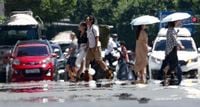On July 8, 2025, the Seoul metropolitan area and Gyeonggi Province experienced a historic heatwave, with temperatures soaring above 40 degrees Celsius for the first time recorded in July. This unprecedented heatwave shattered previous records and prompted heatwave warnings across the region, highlighting a severe and ongoing public health and environmental challenge.
According to the Korea Meteorological Administration (KMA), the temperature in Gwangmyeong's Cheolsan-dong area reached 40.2 degrees Celsius at 3:42 PM, while Paju's Gwangtan-myeon Sinsan-ri area recorded 40.1 degrees Celsius at 3:24 PM. These readings marked the highest temperatures nationwide this summer and the first time July temperatures breached the 40-degree mark in recorded history.
Meanwhile, Seoul itself reached a peak temperature of 37.1 degrees Celsius at around 2 PM, setting a new record for the highest temperature in early July since weather observations began in 1907. These extreme temperatures affected the entire Seoul metropolitan area, including most of Gyeonggi Province and Incheon (except Ongjin-gun), which were all placed under heatwave warnings.
The heatwave has been relentless, with much of Gyeonggi Province experiencing temperatures around 35 degrees Celsius for several days leading up to this record-breaking event. Some areas, such as Icheon, Anseong, Yeoju, Yangpyeong, Gwangju, and Gapyeong, have been under heatwave warnings since June 30, while Hanam and Yongin have experienced continuous heat warnings since July 2. The Meteorological Administration noted that temperatures have been consistently more than 5 degrees Celsius higher than average, with many parts of Seoul, Incheon, and Gyeonggi also suffering from tropical nights—when temperatures remain uncomfortably high even overnight.
The KMA forecasts that this extreme heat will persist until at least July 16, when nationwide rain is expected to bring some relief. Until then, strong easterly winds and intense sunlight will continue to fuel the heatwave and prolong tropical nights across the metropolitan area.
Health authorities have expressed grave concern over the risks posed by the extreme heat. The Korea Disease Control and Prevention Agency (KDCA) reported that from May 15 to July 7, a total of 977 heat-related illness cases have been recorded nationwide, nearly reaching the 1,000 mark. In light of this, public health officials strongly advise residents, particularly vulnerable groups such as the elderly, children, and pregnant women, to avoid prolonged outdoor activities during peak heat hours, stay indoors as much as possible, and maintain proper hydration.
Additionally, authorities have warned about the potential dangers of air conditioner outdoor units overheating, urging caution and regular maintenance to prevent malfunctions during this critical period. For those working outdoors or involved in manual labor, the KMA emphasized the need for special vigilance, as the combined effect of high temperatures and humidity can make the perceived heat even more intense and dangerous.
Beyond human health, the agricultural sector is also grappling with the impact of the heatwave. Farmers and livestock handlers have been advised to operate sprinklers and fans in barns, adjust the density of livestock to reduce heat stress, and ensure animals have continuous access to cool water. These measures aim to mitigate the risk of heat-related damage to crops and animals, which could have broader economic consequences if the heat persists.
The ongoing heatwave has also prompted local governments to implement measures to protect citizens. For example, smart shade installations have been set up in public spaces to provide relief from direct sunlight. These efforts are part of a broader strategy to minimize heat exposure and prevent heat-related illnesses during this intense summer period.
The severity of this heatwave underscores the increasing challenges posed by climate variability and extreme weather events. With temperatures reaching unprecedented levels in historically cooler months, residents and authorities alike are facing a new normal that demands adaptation and resilience. As the summer progresses, the focus remains on safeguarding public health, supporting vulnerable populations, and protecting the environment and economy from the adverse effects of such extreme heat.
As the heatwave continues to grip the Seoul metropolitan area and Gyeonggi Province, officials urge everyone to stay alert, take preventive measures seriously, and look out for signs of heat-related illnesses. The hope is that the anticipated rainfall after July 16 will finally bring some respite from this relentless heat, but until then, vigilance and care remain paramount.

